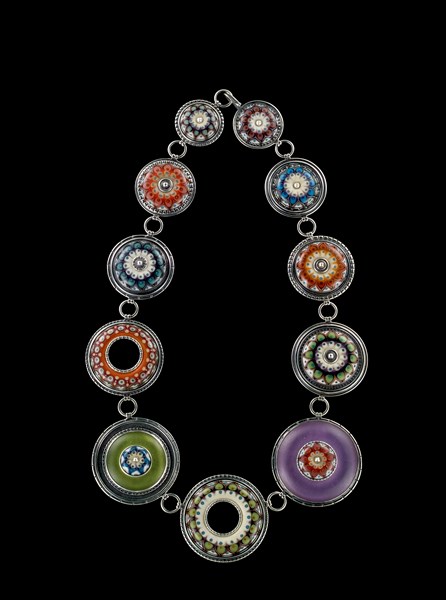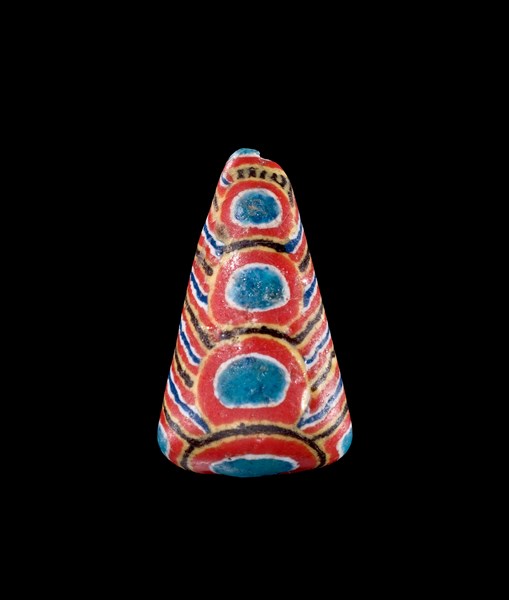CORNING, N.Y., May 8, 2013 (GLOBE NEWSWIRE) -- Symbolizing power, enabling ornamentation, and facilitating trade, glass beads are miniature masterpieces that have played significant roles throughout time and across cultures. This summer, a major exhibition at The Corning Museum of Glass will explore glass beads and beaded objects made by various cultures, representing 3,500 years of human history. On view from May 18, 2013, to January 5, 2014, Life on a String: 35 Centuries of the Glass Bead will showcase, for the first time, many important works from the large historical glass bead collection of The Corning Museum of Glass as well as objects on loan from seven institutions.
"Glass beads are truly remarkable objects—they are the miniature masterpieces of the Museum's collection," says Karol Wight, executive director and curator of ancient and Islamic glass. "These works are important not only for their artistry, but also for the way they are used to convey social and political messages, and for the manner in which beading traditions have been carried on over many centuries."
Life on a String will explore the use of glass beads for fashion and ornament, as symbols of power and wealth, as traded goods, and as objects of ritual, as well as illuminate the processes of beadmaking and beadworking. Curated by Adrienne V. Gennett and designed by noted industrial and product designer Harry Allen, the exhibition will present nearly 200 objects, many of which have never before been on display.
Highlights of the exhibition include early Venetian chevron and millefiori beads, Roman mosaic beads, West Africa bodom beads, Egyptian eye beads, Chinese horned eye beads, Japanese magatama beads, Bohemian beads imitating precious stones, North American beadworked garments, and contemporary beaded objects by Joyce Scott and David Chatt.
The size of glass beads often belies their importance. They can represent wealth, symbolize gender and family relationships, or indicate social status, all through meaning signified in their color and patterning. Economic and political relationships around the globe—especially during the period of European colonization—are embodied in the beads manufactured in Europe and distributed in Africa and North America. Their styles influenced indigenous bead production, and ultimately, beads made in formerly colonized lands followed a reverse course back to Europe.
Traded globally for centuries, glass beads are among the earliest attempts at glass production and have been found at ancient glass manufacturing sites in the eastern Mediterranean from the second millennium B.C. The beads in the exhibition demonstrate the variations in manufacturing techniques used to create beads and beaded objects through time. A loom for beading and molds used to make powdered glass bodom beads will be on display along with images of beads being produced around the world, to illuminate the vast and rich history of techniques for bead production.
A new companion book, Glass Beads: Selections from The Corning Museum of Glass, by exhibition curator Adrienne V. Gennett, former curatorial assistant of The Corning Museum of Glass, now assistant curator of collections and education at the University Museums at Iowa State University, with contributions by Tina Oldknow, the Museum's curator of modern glass, will be available to purchase from the Museum's GlassMarket (glassmarket.cmog.org) in May 2013. The book features fifty highlights of beads and beaded objects in the Museum's collection.
On Saturday, May 18, 2013, the Museum will offer free programs as part of the Association of Art Museum Directors' (AAMD) Art Museum Day, coinciding with International Museum Day. Visitors are invited to take free guided tours of Life on a String with exhibition curator Adrienne Gennett and watch free flameworking demonstrations to see how glass beads are made. Participate in Art Museum Day from anywhere in the world via social media. Join online using the hashtag #artmuseumday, and see what others are sharing on Twitter at @corningmuseum, and on Facebook at www.facebook.com/corningmuseumofglass.
During the run of the exhibition, the Museum will offer special narrated flameworking demonstrations to show techniques used to make glass beads, and visitors will have the opportunity to create beads in hands-on Make Your Own Glass experiences. On October 18-19, 2013, the Museum will host its Annual Seminar on Glass focused on glass beads and beadwork through time and from around the world.
Lenders to the exhibition include The Metropolitan Museum of Art, American Museum of Natural History, Eliot Elisofon Photo Archives at the National Museum of African Art, Rockwell Museum of Western Art, Fenimore Art Museum, Johnson Museum of Art at Cornell University, and Longyear Anthropology Museum at Colgate University.
About The Corning Museum of Glass
The Corning Museum of Glass (www.cmog.org) is the foremost authority on the art, history, science, and design of glass. It is home to the world's most important collection of glass, including the finest examples of glassmaking spanning 3,500 years. Live glassblowing demonstrations (offered at the Museum, on the road, and at sea on Celebrity Cruises) bring the material to life. Daily Make Your Own Glass experiences at the Museum enable visitors to create work in a state-of-the-art glassmaking studio. The campus in Corning includes a year-round glassmaking school, The Studio, and the Rakow Research Library, the world's preeminent collection of materials on the art and history of glass. Located in the heart of the Finger Lakes Wine Country of New York State, the Museum is open daily, year-round. Kids and teens, 19 and under, receive free admission.
To access high-resolution images visit: www.cmog.org/press
Photos accompanying this release are available at:
http://www.globenewswire.com/newsroom/prs/?pkgid=18592, caption: Constellation Necklace Kristina Logan (American, b. 1964) United States, Portsmouth, New Hampshire, 2011 Lampworked glass and pâte de verre; sterling silver L. 60.8 cm, Diam. (largest disk) 5.3 cm.
http://www.globenewswire.com/newsroom/prs/?pkgid=18593, caption: Kiffa Bead West Africa, Kiffa, Mauritania, late 20th century Opaque white, yellow, deep blue, red, black Powder glass H. 2.4 cm, W. 1.4 cm.

